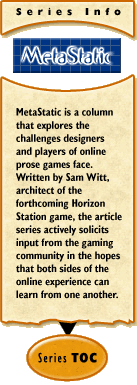 Community Building, Part II
Community Building, Part II
by Sam Witt
November 22, 2000
Last week I kicked around the topic of community, and this week I'll continue that conversation. Sort of.
See, one of the things I ran into when going over the design concepts for Horizon Station was the idea for characters to build things. Weapons, clothes, spaceships, free-floating satellite dwellings – I have plans for this huge variety of things I want characters to be able to build.
The problem wasn't the concept itself, but the conflicting ideas of creation and destruction. Both are integral to my ideas for what a game should be, and what it should offer its players. But the players who love to blow things up aren't generally interested in hand-tailoring an entire wardrobe for their characters, and vice versa.
But I don't want the two groups to drift apart and not have any contact with one another. A key part of any online game is that all the players should have a reason to mix and mingle. It's my belief that even the most powerful and experienced of characters should, from time to time, have reason to seek out the neophyte character.
My first idea was to create a wholly artificial construct that would encourage more experienced characters to assist those new to the game, but I didn't like the idea of such obvious patronage. Everyone in a game should feel like their character matters, and having veterans essentially holding the hands of the novices flew in the face of that philosophy. Not to mention that I've seen it tried in other games, and it ends up with new characters being treated as little more than another commodity by those with more experience.
So already the game design was pulling the community into four different directions: combatants versus creators, and experts versus novices. Referring back to an old rule of thumb of game mastering, it became apparent that the only way to get these four groups to work together smoothly would be if they each had a carrot that at least one of the other groups wanted.
With that in mind, I looked over the item creation system that I'd been planning. One of the key elements of that system was the idea that you only gain skill when you're attempting something that is at the bleeding edge of your own experience. After all, you probably won't learn much from putting on a bandage if you're already able to perform open-heart surgery.
Tossing all that into a blender yielded a smooth and frosty blend of risk, reward, and community. The system only rewards you for doing things that are difficult, making it unlikely that experienced members of the creator sub-community would be competing with their less-skilled cousins. Those who can make antigravity rotors won't have the same customers as the craftsman who is making gasket covers, and vice versa. In a similar manner, the truly lethal members of the destructive community wouldn't have much reason to go after the weaker creatures being hunted by those just starting out on the same path: hunting enemies that are at the limit of your abilities not only increases your own skill, but will surely yield better loot, as well.
But that still didn't bring the community together, just kept it from tearing itself apart in a senseless competition over limited resources. What I needed was a way to draw the groups together, which is what prompted the idea of components.
The short version is that all advanced items that can be created are put together from a host of components that are generally easier to make. Unfortunately, these components take a lot of time to make, and do little to advance the skills of characters capable of making top-of-the-line gear. But without these simpler items, no engineer will ever be able to make the Supreme Gun of Hurtiness. And we do know that the more destructive characters want the Supreme Gun of Hurtiness.
Fortunately for these looter characters, their foes are likely to drop the pieces needed to construct the components of the SGoH. And fortunately for the neophyte grease-monkey, the more experienced engineers don't want to waste their time making these components. This brings up the community-binding chain of supply wherein the looters (of all skill levels) bring in the raw materials, which the less-skilled creators then turn into finished components that are sold to be turned into a variety of trade goods.
So there you have it, a simple version of the methods I think are going to prove effective in tying the community together. Use the link below to tell me if you think I'm crazy or not and I'll see you in seven for Metastatic Episode 4: Hate is Good.



